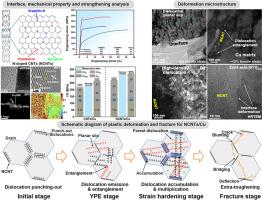氮掺杂碳纳米管制备Cu纳米复合材料的界面强化、变形和电输运行为
IF 7
2区 材料科学
Q1 MATERIALS SCIENCE, MULTIDISCIPLINARY
引用次数: 0
摘要
碳纳米管(CNTs)与Cu基体之间固有的不相容性通常导致了弱界面的形成,从而降低了强化效率。为了解决上述难题,通过等离子体处理制备了氮掺杂碳纳米管(NCNT),用于增强Cu基复合材料。研究发现,除了促进均匀分散外,氮掺杂处理还有利于NCNTs/Cu界面的鲁棒性,并与具有强烈局域法向应变的无序区相关。这种界面保证了载荷从基体向NCNTs的准确传递,从而使NCNTs/Cu的屈服强度优于原CNTs/Cu。同时,n介导的CNT-Cu界面提供了强大的位错钉住力,在塑性变形早期促进位错平面滑移,出现“屈服点延伸”,位错倍增速度快,位错速度低。在随后的变形过程中,NCNTs/Cu中实现了充分的界面位错相互作用和裂纹桥接和挠曲引入的额外增韧,从而延迟了颈缩。电输运分析表明,掺N降低了界面非弹性散射,加速了从Cu基体到NCNT的额外电子转移。碳纳米管的这种氮掺杂特性被强调,以解决其突出的机电性能协同作用的贡献。本文章由计算机程序翻译,如有差异,请以英文原文为准。

Interface-dominated strengthening, deformation and electrical transport behaviors of Cu nanocomposites rendered by nitrogen-doped carbon nanotubes
The intrinsic incompatibility between carbon nanotubes (CNTs) and Cu matrix generally renders the formation of weak interface and thus low strengthening efficiency. To address the above dilemma, a nitrogen-doped CNT (NCNT), fabricated via plasma treatment, was used to reinforce Cu matrix composites. It is found that in addition to promoting the homogeneous dispersion, nitrogen-doped treatment of CNTs facilitates the robust interface in the NCNTs/Cu, associated with disorder area featuring intense localized normal strain. Such interface guarantees the accurate load-transfer from the matrix to NCNTs, thereby contributing to the prominent yield strength of NCNTs/Cu over raw CNTs/Cu. Meanwhile, the N-mediated CNT-Cu interface provides strong dislocation pinning force, which turns to encourage dislocation planar slip at the early plastic deformation and occurrence of “yield point elongation”, coupled with rapid dislocation multiplication and lower dislocation velocity. The sufficient interface dislocation interactions and extra-toughening introduced by crack bridging and deflection were achieved in the NCNTs/Cu during subsequent deformation, thereby delaying necking. Electrical transport analysis demonstrates that the doped N lowers the interface inelastic scattering and accelerates extra electron transfer from Cu matrix to NCNT. Such nitrogen-doping characteristics of CNT were accentuated to address their contribution to the prominent mechanical-electrical property synergy.
求助全文
通过发布文献求助,成功后即可免费获取论文全文。
去求助
来源期刊

Materials Science and Engineering: A
工程技术-材料科学:综合
CiteScore
11.50
自引率
15.60%
发文量
1811
审稿时长
31 days
期刊介绍:
Materials Science and Engineering A provides an international medium for the publication of theoretical and experimental studies related to the load-bearing capacity of materials as influenced by their basic properties, processing history, microstructure and operating environment. Appropriate submissions to Materials Science and Engineering A should include scientific and/or engineering factors which affect the microstructure - strength relationships of materials and report the changes to mechanical behavior.
 求助内容:
求助内容: 应助结果提醒方式:
应助结果提醒方式:


